
In a long-awaited report released Tuesday, a panel of planetary scientists recommended NASA prioritize development of a flagship robotic mission that would orbit Uranus, a distant world with 27 known moons that has not been explored since a fleeting visit by the Voyager 2 spacecraft 36 years ago.
The planetary science decadal survey report, released by the National Academies of Sciences, Engineering, and Medicine, provides NASA with a roadmap for the next decade of solar system exploration. The U.S. agency has a long-standing policy of following the recommendations from the once-in-a-decade reports.
Scientists said the second priority for NASA’s planetary science program should be the development of a robotic mission to orbit and land on Saturn’s moon Enceladus, which previous missions have shown harbors an ocean of liquid water buried under a global ice sheet, with plumes of material erupting from the moon’s south pole.
The Uranus and Enceladus missions received rankings above other mission concepts considered by the decadal survey panel. NASA prepared 11 mission concept studies for review by the decadal survey committee, and the panel determined six of the concepts had “exceptional scientific merit.”
Those concepts included the Uranus Orbiter and Probe and the Enceladus Orbilander, which received top ranking. Other concepts studied by the decadal survey committee included landers to go to Jupiter’s moon Europa and the solar system’s innermost moon Mercury, a flagship mission to orbit and land on Venus, and a robotic mission to orbit Neptune and repeatedly fly by its planet-sized moon Triton.
“We’d like to see all these missions get done, right? So you’re choosing among missions that are all fantastic missions,” said Robin Canup, Robin Canup, assistant vice president of the planetary sciences directorate at the Southwest Research Institute, and co-chair of the National Academies’ steering committee for the decadal survey.
The Venus flagship mission was judged to be the most technically risky and expensive of the group. An independent cost assessment from the Aerospace Corp. estimated the Uranus Orbiter and Probe mission would cost about $4.2 billion, and the Enceladus orbiter and landing mission would come in at $4.9 billion.
The decadal survey ranked the Neptune-Triton flagship lower than the Uranus mission due to trajectory constraints in the 2030s. The alignment of the planets make it easier for a spacecraft to launch toward Uranus in that decade.
“The UOP (Uranus Orbiter and Probe) would conduct a multi-year orbital tour to transform knowledge of ice giants in general, and the Uranian system in particular, through flybys and the delivery of an atmospheric probe,” the National Academies said in a press release. “The report states that UOP would be programmatically complementary to the flagship missions underway, and that a launch within the 2023-2032 decade is viable on currently available launch vehicles.”
Uranus circles the sun at twice the distance of Saturn, and is the only planet in the solar system that rotates on its side, on an axis tilted more than 90 degrees relative to its orbit.
NASA has sent missions to orbit Jupiter and Saturn, the solar system’s “gas giant” worlds rich in hydrogen and helium. Uranus and Neptune are smaller “ice giant” planets, with water, ammonia, and methane deep in their atmosphere.
“Except for the fact that it’s on its side, the (Uranus) system is very ordered, with multiple large satellites and a ring system,” Canup said.
Canup said the ice giants are the only class of planet that has not had an orbital mission. “This may, we think, be the most common class of planet in the universe,” she said.
“We don’t have a lot of images from Voyager, but many of these (Uranus) moons are amazing to look at and show signs of activity on their surface,” Canup said. “Miranda is one of the most bizarre objects in the solar system, at least to me.
“Our goal is to see that mission initiated as soon as possible,” she said. “We want to get to the ice giants. We don’t want an ice giant mission to happen in the next decade, we want it to happen in this decade. (The fact) that there is such clear international interest in collaborating on that mission is obviously fantastic, and it improves the chances that that mission can be started sooner rather than later, from our perspective.”

“The (Enceladus) Orbilander would search for evidence of life on Enceladus, a moon of Saturn, from orbit and during a two-year landed mission that would perform detailed studies of fresh plume material originating from Enceladus’ interior ocean,” the National Academies said.
The Uranus mission could launch as soon as 2031 or 2032 on a commercial heavy lift rocket, like SpaceX’s Falcon Heavy, if NASA has the budget to quickly start work on the project. The Enceladus mission would require a more powerful super-heavy lift launch vehicle, such as NASA’s Space Launch System, for launch no earlier than the late 2030s, scientists wrote in the decadal survey report.
“Options are available for launch (of the Enceladus Orbilander) on a heavy lift vehicle with the inclusion of a solar-electric propulsion stage and/or a Jupiter gravity assist (if available),” scientists wrote. The document did not mention any commercial super-heavy rockets, like SpaceX’s Starship vehicle currently in development.
The decadal survey panel ranked an Enceladus lander over a landing mission to Jupiter’s icy moon Europa. Both worlds have global oceans of liquid water, but Enceladus offers some advantages, according to Phil Christensen, co-chair of the decadal survey panel and a professor in the School of Earth and Space Exploration at Arizona State University.
Enceladus has more active and sustained plumes erupting through fissures in its icy crust, and the radiation environment there is more benign than at Europa, allowing a spacecraft to survive longer.
“We just felt that if we have one opportunity to explore an ocean world with a flagship mission, Enceladus provided the best opportunity to do that,” Christensen said.
The most recent decadal survey report, released in 2011, recommended NASA pursue a Mars Sample Return mission and a robotic explorer to study Europa.
NASA responded by beginning development of the Perseverance rover, which launched in 2020 and landed on Mars last year to begin collecting rock samples for return to Earth in the early 2030s. The Europa Clipper mission is now being built at the Jet Propulsion Laboratory in California for launch in 2024. Once it arrives at Jupiter, Europa Clipper will repeatedly fly by Europa at relatively low altitude.
Scientists in this year’s report said NASA should continue work on those missions, adding that the “highest scientific priority” for the agency’s robotic exploration efforts should be completing the Mars Sample Return campaign “as soon as is practicably possible with no increase or decrease in its current scope.”
Another section of the decadal survey report recommended NASA “fully support the development, timely launch, and subsequent operation of the NEO Surveyor,” an infrared telescope to detect asteroids that could threaten Earth. NASA’s planetary defense program launched its first space mission last November, a project called the Double Asteroid Redirection Test that will attempt to demonstrate the ability to nudge a space rock off its trajectory in a targeted collision with a small asteroid later this year.
After DART and the NEO Surveyor, which is set for launch in 2026, NASA should next focus on demonstrating its ability to develop a “rapid-response” mission to fly by a relatively small near-Earth asteroid, testing capabilities to better prepare for a short-warning time asteroid threat to Earth.
“We, as a committee, worked very hard to prioritize and balance the major program elements so that we had a portfolio of programs and missions, research, and technology that really moves planetary science forward,” Christensen said.

The decadal survey report also issued recommendations on NASA’s New Frontiers and Discovery programs, which develop medium-class and relatively low-cost solar system science probes.
The New Frontiers missions are cost-capped at $900 million for pre-launch development costs, about one-fifth the cost of a flagship science mission. Development of Discovery-class science missions must cost less than $500 million, according to NASA’s most recent numbers.
NASA solicits proposals from outside science teams for each New Frontiers and Discovery mission, while development of flagship missions is typically managed at a NASA center.
National Academies panels have previously provided NASA with a list of candidate targets for New Frontiers missions, including a comet surface sample return, a sample return from the far side of the moon, a mission to Enceladus, a Saturn atmospheric probe, a Venus descent probe or lander, a spacecraft to explore Jupiter’s volcanic moon Io, and a lunar geophysical network to probe the moon’s internal structure.
Previous New Frontiers-class missions include NASA’s New Horizons probe to Pluto, the Juno mission orbiting Jupiter, and the OSIRIS-REx asteroid sample return mission.
Scientists in the decadal survey reported recommended NASA amend the list of New Frontiers mission targets for future selection rounds to include:
• A mission to orbit and land on a Centaur asteroid
• A mission to return samples from the dwarf planet Ceres
• A comet surface sample return
• A mission to conduct multiple flybys of Saturn’s moon Enceladus
• A lunar geophysical network
• A Saturn atmospheric probe
• A orbiter to Saturn’s moon Titan
• A Venus In Situ Explorer
The lunar sample return mission and the Io volcano explorer dropped off the New Frontiers list. But those science objectives could be achieved by NASA’s Artemis program, which aims to send astronauts back to the moon, and through the lower-cost Discovery solar system science program.
The decadal survey also urged NASA to raise its New Frontiers cost limit o $1.65 billion, and boost its Discovery cost limit up to $800 million, figures that would add operations costs under the cost cap. Scientists also recommended NASA allow for more adjustments later in the decade to account for inflation.
The National Academies research panel recommended NASA continue selecting two Discovery missions in each round of proposals, a practice the agency started in recent years after previously choosing only one winning proposal per round. The decadal survey panel also wrote NASA should eventually begin selecting two New Frontiers-class missions during each proposal round.
“Those small and medium class missions are the lifeblood of our community,” Christensen said, adding that they bring in new ideas, new scientists, and new technology that can be applied to a broader range of planetary science investigations.

Scientists writing in the decadal survey report expressed their continued support of NASA’s Mars program, adding that the agency should prioritize a “Mars Life Explorer” mission, which would seek signs of existing life on the Red Planet. The multi-launch Mars Sample Return program, begun with the launch of the Perseverance rover, is focused on searching for evidence of past life on Mars.
The Mars Life Explorer will be an “in situ lander that looks for modern biosignatures,” Christensen said.
NASA has been working on early stages of planning a Mars Ice Mapper mission in partnership with Canada, Japan, and Italy, but the White House proposed canceling that project in the fiscal year 2023 budget request released last month.
The decadal survey also offered recommendations for NASA’s science division to work with the agency’s human spaceflight directorate on research objectives for astronauts landing on the moon.
Scientists recommended NASA develop a rover called Endurance-A, which would land on the moon aboard a commercial spacecraft and collect “a substantial mass of high-value samples across a long traverse” before delivering the specimens to astronauts on the moon, who would return them to Earth for analysis.
The robotic Endurance-A rover could collect up to 220 pounds (100 kilograms) of lunar samples from regions inaccessible to astronauts.
“We are so excited about this Endurance-A rover concept,” Canup said. “To us, this takes the best of what the scientific robotic (missions) that NASA does and combines it with the human exploration side. We do rovers, we do geology, we know how to do very highly targeted sample collection.
“We do that, and we deliver these samples to the astronauts, and they allow us to get a nice massive sample back,” Canup said.
The decadal survey panel recognized that NASA’s planetary science division will need a budget increase to begin work on all of the recommended projects in the next decade. The committee gave NASA a ranked list of priorities to carry out if the agency’s funding remains level.
NASA officials said they will review the recommendations from the decadal survey and release a preliminary response in about 90 days.
Email the author.
Follow Stephen Clark on Twitter: @StephenClark1.
